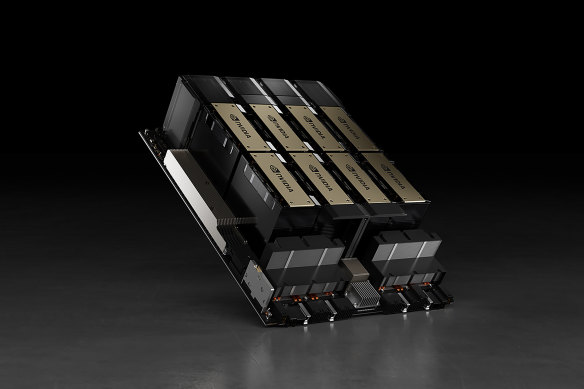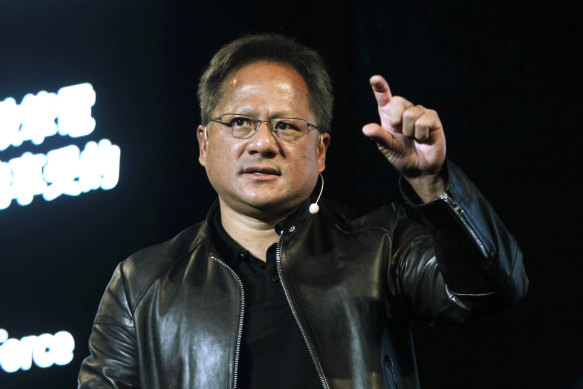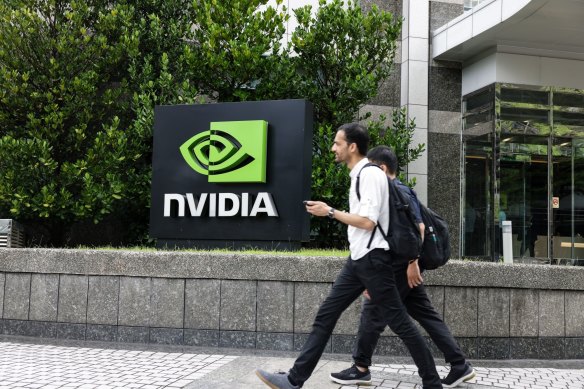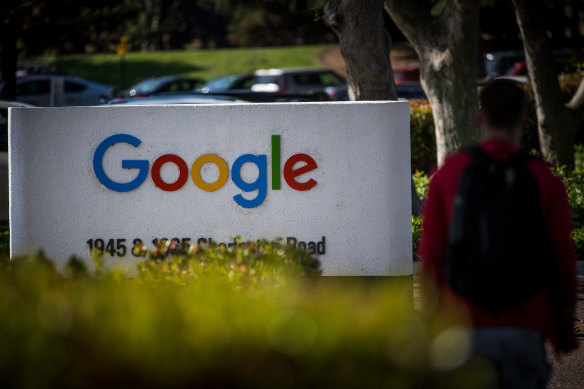
Save articles for later
Add articles to your saved list and come back to them any time.
Ancient civilisations hunted for spice; in the 20th century we fought wars for oil. In 2023, the world’s most precious commodity is an envelope-sized computer chip.
The H100, a rectangular black maze of circuits with a shimmering microchip at its centre, is a niche piece of equipment even by Silicon Valley’s nerdy standards.
The H100 is at the centre of a global race for intelligence.Credit: AP
Its $US40,000 ($62,380) price tag is exceptional for a computer processor, although even if you have the cash, good luck getting your hands on one. The half a million H100s expected to be made this year are already sold out.
Not that one chip would do you much good. Last week, it emerged that Saudi Arabia had ordered some 3000 H100s.
Almost all of the chips are being snapped up by the richest companies in the world: Microsoft, Amazon, Google and Mark Zuckerberg’s Meta are believed to account for the vast majority of demand.
Joe Biden has banned their export to China, under rules designed to prevent sensitive technology ending up in enemy hands.
While more than a trillion microchips – the brains of our electronics – are made each year, the H100 is at the centre of a global race for intelligence.
The chip is described by its maker, the Silicon Valley giant Nvidia, as the world’s first designed for “generative” artificial intelligence, the type of powerful, “creative” AI behind technologies such as ChatGPT that has taken the world by storm.
This year, the rise of systems like ChatGPT have rekindled warnings that artificial intelligence should be treated with the same seriousness as nuclear weapons and climate change.
Its makers have been summoned to Downing Street and the White House and threatened with new regulations.
The strikes that have ground Hollywood to a halt, for example, are driven partly because actors and writers fear being replaced by AI replicas that do not demand wages.
How the chip works
Type a query into ChatGPT and it will confidently spit out an erudite answer in a split second. The heavy lifting, though, is being done by thousands of Nvidia chips in an enormous humming server farm hundreds of miles away.
The AI boom has catapulted the Californian company into one of an elite group of businesses worth more than one trillion dollars and made its founder, Jensen Huang, the world’s 32nd-richest person – with a $US39 billion fortune.
The H100’s position as the key to the AI boom is really a happy accident. For most of its 30 years, Nvidia has produced chips, known as GPUs, used to power 3D graphics in video games.
Nvidia founder Jensen Huang has made the company the world’s most important designer of artificial intelligence chips.Credit: AP
Traditional computer processors, known as CPUs, can perform complicated calculations, but generally only one at a time. In contrast GPUs can carry out hundreds of simple calculations at once.
That made them adept at tasks like modifying colourful pixels in a video game. What the company did not count on was that its chips would also be perfect for the rapid data processing required for artificial intelligence.
In 2012, Google researchers used 16,000 CPUs to train rudimentary AI software that could recognise pictures of cats. A year later, researchers achieved the same results with four GPUs.
“It’s partially incredible foresight, and partially just blind luck,” says Jay Goldberg, a Silicon Valley chip industry expert.
“The way that AI works is it’s the same maths equation, just done over and over and over again in vast quantities. And GPUs are really good at that.”
Luck notwithstanding, people are now buying the chips as fast as Nvidia can make them. “GPUs at this point are considerably harder to get than drugs,” Elon Musk told a conference in May.
While rival companies make GPUs, one technology investor describes Nvidia as “the only game in town”. And for those that want the best, only the H100 will do.
The state of the art model that powers ChatGPT, for example, was developed using an estimated 25,000 A100s, the chip’s predecessor.
The new version is an order of magnitude more powerful: accomplishing in 20 hours what would take the A100 a week.
For all their ascribed “intelligence”, the best AI systems are really a product of the best training, and that is really a matter of having the best computer.
The first version of the model behind ChatGPT had around 100 million variables known as parameters; the latest is believed to have trillions.
No surprise, then, that tracking down the best chips has become an act of desperation. “There’s one thing that can provide competition to H100 GPUs: Taylor Swift concert tickets,” Aravind Srinivas, an AI entrepreneur, tweeted.
One online commentator refers to it as the “Opec of GPUs”.
Silicon Valley bosses trade stories of their efforts to obtain the fabled chips: some tap up their well connected venture capital investors for contacts, others beg friends at universities for a chance to plug in to their research labs.
There is only one guaranteed way to obtain a steady supply, however: hundreds of millions of dollars. That means there are now broadly two camps of customers that can buy chips in the quantities that matter: tech giants, and nation states.
The global race for AI supremacy
Within a few years, AI has moved from a promising technology to a critical national priority.
In 2017, China outlined a “new generation AI plan” vowing to make the country the “primary” centre for innovation by 2030. According to the US-based Center for Security and Emerging Technology, Beijing is seeking to push towards “artificial general intelligence”, a system capable of matching human intelligence.
Nvidia may be an American company, but its highest-powered chips are exclusively made in Taiwan, making the entire AI industry dangerously exposed to the threat of Chinese invasion.Credit: Bloomberg
The plan has been met with a volley of US sanctions designed to cripple Chinese efforts in AI.
Last year the White House barred Nvidia from selling its H100 and A100 chips to China without a licence. The company has rushed out new versions of the chips to evade the controls, and the Biden administration is now expected to respond with a new set of rules.
Saudi Arabia and the United Arab Emirates are both investing heavily in chips, developing their own “large language models” similar to ChatGPT.
This year, the rise of systems like ChatGPT have rekindled warnings that artificial intelligence should be treated with the same seriousness as nuclear weapons and climate change.
According to the Financial Times, the Saudi software, being developed at the oil-rich state’s Kaust research institution, is largely being created by Chinese researchers whose education bars them from working in America.
In the US, the Biden administration is spending tens of billions to encourage microchip companies to set up factories in America, a plan that has been described as “one of the biggest government interventions since the Second World War”.
Nvidia may be an American company, but its highest-powered chips are exclusively made in Taiwan, making the entire AI industry dangerously exposed to the threat of Chinese invasion.
AI weapons are an obvious example of just how important the new tech is. Autonomous drones that can see the world around them and respond accordingly have already changed the battlefield in Ukraine, and AI has successfully flown F-16 fighter jets.
But the risks are wider: generative AI programmes similar to ChatGPT threaten mass-scale cyber attacks and the industrialisation of fake images.
Mike Wooldridge, of the Alan Turing Institute, says widespread disinformation is the greatest immediate risk from AI.
In 2016, Russia was accused of meddling in Donald Trump’s election using armies of internet trolls in Moscow offices. By next year’s election, AI is likely to be capable of spinning up infinite numbers of divisive online comments and hoax pictures that are indistinguishable from the real thing.
Old fashioned economic conflict is also a concern, however.
Sam Altman, the chief executive of OpenAI, the company behind ChatGPT, has predicted that once AI software gets to a level of sophistication where it can improve itself, it will kick off a “recursive loop of innovation” that will see it create “phenomenal wealth”, not to mention instant scientific breakthroughs.
Not everyone is as optimistic, but if even the less radical predictions about how AI will change economies come true, countries will not want to be left behind.
The new superpowers
This all may be a sideshow, however. For unlike nuclear weapons, it is not nation states at the forefront of AI development, but a handful of giant technology companies.
This year, Google will spend $US33 billion on buildings and equipment, with spending on infrastructure such as Nvidia chips rising by around a third.
Netflix – satirised in an episode of Black Mirror that imagined a future where actors were replaced by AI holograms – is advertising machine learning jobs that pay up to $US900,000, more than four times the prime minister’s salary.
If AI power is a product of the computing strength behind it, national governments pale compared to the resources available to private enterprises.
Inflection AI, a start-up run by DeepMind’s co-founder Mustafa Suleyman and funded by Microsoft, is building an AI supercomputer with 22,000 H100 chips.
Amazon, Microsoft and Google, the so-called “hyperscalers” that run the data centres an increasing proportion of the world’s IT runs on, are lining up orders for tens of thousands each.
The world’s tech giants are driving demand for the elusive chips.Credit: Bloomberg
Meta may require 100,000, according to one analysis.
Goldberg says that the “super seven” giant IT companies – adding in the three Chinese companies of Baidu, Alibaba and Tencent – are responsible for approaching 100 per cent of demand for Nvidia’s top chips.
Altman, perhaps the most prominent figure in AI today, talks about OpenAI in the same language one would typically reserve for nation states. He says that in future its leader could be democratically elected.
For now, though they are answerable to shareholders and employees, which has led to questions about whose side these companies are really on.
In 2019, employees at Microsoft opposed the company’s work with the US military, writing that “we did not sign up to develop weapons”.
The prior year, protests at Google forced the company to halt work on a drone contract for the Pentagon.
Alex Karp, the chief executive of Palantir, an AI company used by the CIA to help track down Osama bin Laden, recently warned that such indecision would be comparable to Robert Oppenheimer refusing to build the atomic bomb, and that no such quandary exists in China.
“Our hesitation, perceived or otherwise, to move forward with military applications of artificial intelligence will be punished,” he said.
Time may be running out for this to be decided.
Demis Hassabis, the founder of DeepMind and Britain’s most prominent AI figurehead, says artificial general intelligence, the point at which AI development reaches a potentially unstoppable velocity, could happen within a decade.
As for the company powering this revolution, this month Nvidia unveiled a yet more powerful version “GH200”. The world is scrambling for the superchip at the heart of the AI race, but it may soon be yesterday’s news.
Telegraph, London
The Business Briefing newsletter delivers major stories, exclusive coverage and expert opinion. Sign up to get it every weekday morning.
Most Viewed in Technology
From our partners
Source: Read Full Article



